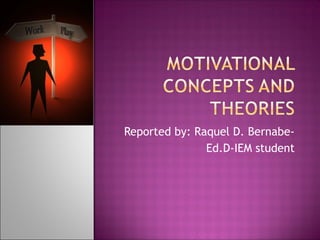
Motivational concepts and theories1
- 1. Reported by: Raquel D. Bernabe- Ed.D-IEM student
- 2. is the force that initiates, guides and maintains goal-oriented behaviors. It is what causes us to take action, whether to grab a snack to reduce hunger or enroll in college to earn a degree. The forces that lie beneath motivation can be biological, social, emotional or cognitive in nature.
- 6. According to Arnold, there are 3 components of motivation: ● direction – what a person is trying to do ● effort – how hard a person is trying ● persistence – how long a person keeps on trying Furthermore, literature distinguishes 2 types of factors that influence motivation: ● intrinsic – self generated factors (responsibility, freedom to act, scope to use and develop skills and abilities, interesting and challenging work, opportunities for advancement) – they have a deeper and longer-term effect ● extrinsic - what is done for people to motivate them (rewards, promotion, punishment) – they have an immediate and powerful effect, but won’t necessarily last long
- 7. ● The underlying concept is the belief that an unsatisfied need creates tension and a state of disequilibrium. To restore balance, a goal is identified that will satisfy the need and a behavior pathway to this goal is selected. ● All behavior is motivated by unsatisfied needs. ● People will be better motivated if their work experience satisfies their needs and wants.
- 9. ● Social ● Safety ● Physiological ● If a lower need is satisfied, the next higher one becomes dominant. ● Higher-order needs provide greatest motivation. ● Different people may have different priorities
- 10. ● About subjective states of satisfaction and desire ● 3 primary categories of human needs ● existence needs – need for material and energy exchange ● relatedness needs – transactions with human environment, process of sharing or mutuality ● growth needs – people make creative or productive efforts for themselves
- 12. ● Based mainly on studies of managers ● 3 most important needs: ● achievement – need for competitive success measured against a personal standard of excellence ● affiliation – need for warm, friendly relationships with others ● power – need to control and influence others
- 13. ● Motivators – factors that really motivate people, ● Hygiene factors – dissatisfiers; their absence would demotivate people, but their presence not necessarily improves motivation; essentially describe the environment, little effect on positive job attitudes Process cognitive theory ● Emphasis on psychological processes that effect motivation and on basic needs ● Concerned with peoples perceptions and the way they interpret and understand it ● People will be highly motivated if they can control the means to attain their goals Expectancy theory ● By Vroom ● Value, instrumentality (belief that if we do one thing it will lead to another), expectancy (probability that action or effort will lead to an outcome) ● Strength of expectations may be based on past experiences ● Motivation is only likely when a clearly perceived relationship exists between performance and an outcome that is seen as a means of satisfying needs ● Porter and Lawler: two factors determining the effort people put into their jobs: ● Value of rewards to individuals in so far as they satisfy their needs ● Probability that rewards depend on effort, as perceived by individuals, their expectation about relationships between effort and reward ● Two additional variables: ● Ability – individual characteristics and skills ● Role perceptions – what he wants to do or thinks he is required to do, good if they correspond with the viewpoint of the organisation
- 15. ● Latham and Locke ● Motivation and performance are higher when individuals are set specific goals ● Goals have to be difficult but accepted ● Feedback on performance ● Participation in goal setting is important – goals need to be agreed ● As long as they are accepted – demanding goals lead to better performance than easy goals
- 16. ● Brehm ● Individuals are not passive receivers but responders ● They seek to reduce uncertainty by seeking control about factors influencing rewards
- 17. ● Adams ● Perceptions people have about how they are being treated as compared with others ● Involves feelings and perceptions, is always a comparative process ● People will work better if they are treated equitably ● Two forms of equity: ● Distributive – fairness people feel they are rewarded in accordance with their contribution and in comparison with others ● Procedural – perceptions of employees about fairness of company procedures ● We hope/expect that the inputs we give into our job equal the outputs we get
- 19. ● Behavioral theory (Skinner): behavior is learnt from experience, learning takes place mainly through reinforcement ● Social learning theory (Bandura) significance of reinforcement as a determinant of future behavior, importance of internal psychological factors, esp. Expectancies ● Attribution theory (Guest) explanation of performance after we have invested considerable effort and motivation in a task; 4 types of explanations: ability, effort, task difficulty, luck; motivation depends on the factor used to explain success or failure
